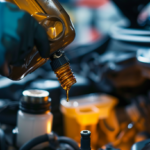Are you experiencing issues with your car’s transmission? Learn how to detect and fix transmission leaks in just a few simple steps. By identifying the signs, checking fluid levels, and locating the source of the leak, you can save yourself time and money on costly repairs. Don’t let a transmission leak leave you stranded on the side of the road. Take control and get your car back on track.
Signs of a Car Transmission Leak
You should look for specific signs to determine whether your car has a transmission leak. One of the first signs to watch out for is a puddle of reddish fluid underneath your vehicle. This fluid is usually the transmission fluid and it should never be ignored. Another telltale sign is if you start experiencing difficulty when shifting gears. If you notice that your gears are slipping or grinding, it could be a sign of a transmission leak. Additionally, if you detect a burning smell coming from your car, especially when you are driving, it may indicate a transmission fluid leak. Lastly, pay attention to any unusual noises coming from your transmission, such as whining or clunking sounds. These signs should prompt you to take your car to a mechanic for further inspection and repair.
Common Causes of Transmission Leaks
One of the most common causes for transmission leaks is due to a failure in the transmission pan gasket or the input shaft seal. These components are responsible for keeping the transmission fluid contained within the transmission system. Over time, the gasket or seal can deteriorate or become damaged, leading to leaks. Another common cause of transmission leaks is loose or damaged transmission cooler lines. These lines carry the transmission fluid to and from the transmission cooler, which helps regulate the fluid temperature. If the lines are loose or damaged, fluid can escape and cause leaks. Additionally, worn or faulty seals on the transmission output shaft or axle can also result in fluid leaks. Regular inspection and maintenance can help identify and address these common causes of transmission leaks.
Checking Transmission Fluid Levels
To keep your car’s transmission running smoothly, it is important to regularly check the transmission fluid levels. Low fluid levels can lead to serious damage and costly repairs. By knowing the signs of low fluid levels and the steps to refill it, you can ensure the longevity of your transmission.
Importance of Regular Checks
Regular checks of your car’s transmission fluid levels are crucial for maintaining optimal performance and preventing potential damage. By regularly monitoring the transmission fluid levels, you can ensure that the system is properly lubricated and cooled. Low fluid levels can lead to increased friction and heat, which can cause wear and tear on the transmission components. This can result in decreased performance and potentially costly repairs. On the other hand, overfilling the transmission fluid can also be detrimental as it can cause the fluid to foam and lose its ability to properly lubricate the moving parts. By performing regular checks and maintaining the fluid at the recommended level, you can extend the lifespan of your transmission and avoid unnecessary breakdowns.
Signs of Low Levels
You should always be aware of the signs of low transmission fluid levels, as they can indicate potential issues with your car’s transmission. One of the first signs you may notice is difficulty shifting gears. This could be due to the lack of lubrication provided by the transmission fluid. Another sign is a burning smell coming from your car’s engine. This could mean that the transmission is overheating due to low fluid levels. You may also experience slipping or jerking movements when driving, as the transmission struggles to properly engage the gears. It’s important to regularly check your transmission fluid levels to ensure they are within the recommended range. If you notice any of these signs, it’s best to have your transmission inspected by a professional to avoid further damage.
Steps to Refill Fluid
Fortunately, if you suspect that your car has a transmission fluid leak, there are steps you can take to refill the fluid and check the transmission fluid levels. To start, park your car on a level surface and engage the parking brake. Open the hood and locate the transmission dipstick, which is usually labeled and located near the engine. Remove the dipstick and use a clean cloth to wipe it off. Then, reinsert it fully into the transmission. Pull it out again and check the fluid level. The dipstick will have markings indicating the minimum and maximum levels. If the fluid is below the minimum mark, you will need to add more transmission fluid. Carefully pour the fluid into the dipstick tube, using a funnel if necessary. Recheck the fluid level and add more as needed. It is important to use the correct type of transmission fluid specified by your vehicle’s manufacturer. Once the fluid level is at the appropriate range, securely reinsert the dipstick and close the hood. Remember to dispose of any used transmission fluid properly.
Identifying the Source of the Leak
To identify the source of the leak in your car’s transmission, there are a few key points to consider. First, take note of the color of the transmission fluid, as this can indicate the type of leak. Next, pinpoint the location of the leak by looking for any visible signs of fluid underneath the vehicle. Lastly, be aware of the common causes of transmission leaks, such as damaged seals or gaskets, to help narrow down the source of the problem.
Color of Transmission Fluid
Check the color of your transmission fluid to determine where the leak is coming from. Transmission fluid is typically red or pink, but it can also be clear or brown. If you notice a bright red fluid leaking from your car, it is likely coming from the transmission cooler lines or the transmission pan gasket. A pink fluid could indicate a leak from the torque converter seal or the transmission input shaft seal. Clear fluid may be leaking from the transmission output shaft seal, while a brown fluid could signal a leak from the transmission cooler lines or the transmission cooler itself. By identifying the color of the transmission fluid, you can narrow down the potential source of the leak and take appropriate action to fix it.
Location of Leak
To pinpoint the location of the leak, you can start by inspecting the underside of your car using a flashlight and a mirror. Get down on the ground and look for any signs of fluid dripping or pooling. Check around the transmission pan, which is located at the bottom of the transmission. Look for any signs of fluid leakage from the pan gasket or the drain plug. Move your inspection to the transmission cooler lines, which run from the transmission to the radiator. Look for any wet spots or signs of fluid leakage along the lines. Finally, examine the output shaft seal, which is located at the back of the transmission. Any signs of fluid around this area could indicate a leak. By carefully inspecting these areas, you can effectively identify the source of the leak and take appropriate action to fix it.
Common Causes of Leaks
Inspect the transmission pan, cooler lines, and output shaft seal to identify the source of the leak. These are the common areas where leaks occur in a car’s transmission system. Start by checking the transmission pan, which is located underneath the vehicle. Look for any signs of fluid pooling or dripping from the pan. Next, examine the cooler lines, which run from the transmission to the radiator. Inspect them for any cracks, loose connections, or signs of leakage. Finally, inspect the output shaft seal, which is located at the back of the transmission. Look for any fluid seeping out around the seal. By carefully inspecting these areas, you can pinpoint the source of the leak and take appropriate action to fix it.
Fixing a Transmission Pan Gasket Leak
You can easily replace the worn-out transmission pan gasket to fix the leak in your car’s transmission. The transmission pan is located underneath your vehicle and houses the transmission fluid. Over time, the gasket can deteriorate and develop leaks, causing transmission fluid to escape. To fix this issue, you will need to drain the transmission fluid and remove the transmission pan. Once the pan is removed, carefully peel off the old gasket and clean the pan and transmission surface. Next, place a new gasket onto the pan and reattach it to the transmission. Lastly, refill the transmission with the appropriate amount of fluid. This simple fix can save you from costly repairs and ensure the smooth operation of your car’s transmission.
Repairing a Transmission Cooler Line Leak
Once you’ve identified a transmission cooler line leak, you can promptly address the issue by tightening the connections and checking for any damaged lines. Start by inspecting the connections at both ends of the cooler line. Use a wrench to tighten any loose fittings. If the leak persists, you may need to replace the damaged section of the line. Carefully examine the entire length of the cooler line for any signs of cracks or holes. If you find any, the line will need to be replaced. Additionally, check the connections at the transmission and the radiator for any signs of damage or wear. If necessary, replace these connections as well. Finally, ensure that all connections are securely tightened to prevent any future leaks.
Resolving a Transmission Seal Leak
To effectively resolve a transmission seal leak, you will need to identify the specific seal that is causing the issue and then replace it accordingly. Start by locating the leak and inspecting the area around it to determine which seal is faulty. Common seals that may be causing the leak include the front pump seal, the input shaft seal, or the output shaft seal. Once you have identified the problematic seal, you will need to remove the transmission to access and replace it. Make sure to drain the transmission fluid before removing the seal. After replacing the seal, reassemble the transmission and refill it with the correct amount and type of transmission fluid. Finally, test the vehicle to ensure that the seal leak has been successfully resolved.
Addressing a Transmission Torque Converter Leak
If you notice a transmission torque converter leak, you should promptly have it inspected and repaired to prevent further damage to your vehicle’s transmission system. The torque converter is a vital component that enables your car to shift gears smoothly. A leak in the torque converter can lead to a loss of transmission fluid, causing the transmission to overheat and potentially fail. To address a torque converter leak, take your vehicle to a reputable mechanic or transmission specialist. They will conduct a thorough inspection to determine the source of the leak and recommend the appropriate repairs. This may involve replacing the torque converter seal or, in more severe cases, replacing the entire torque converter unit. Remember, addressing a torque converter leak promptly can help avoid costly transmission repairs in the future.
Preventing Future Transmission Leaks
To prevent future transmission leaks, you should regularly inspect your vehicle’s transmission fluid levels and address any leaks immediately. Checking the transmission fluid level is a simple task that you can do on your own. Locate the transmission dipstick, which is usually labeled and can be found near the engine. Pull it out and wipe it with a clean cloth. Then, reinsert the dipstick and pull it out again to check the fluid level. If the fluid is low, add more as needed, making sure to use the correct type recommended by the manufacturer. Additionally, it is crucial to address any leaks promptly. Leaks can lead to a decrease in fluid levels, which can cause the transmission to overheat and potentially fail. By regularly inspecting and maintaining your transmission fluid levels, you can prevent future leaks and keep your transmission running smoothly.

Lucas is an experienced vehicle technician with hands-on knowledge of almost every car brand available. Throughout his career, Lucas has worked on a wide range of vehicles, including domestic and foreign models, sports cars, trucks, and SUVs.





